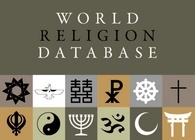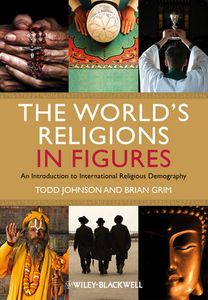International Religious Demography
Quantitative Assessment of the World’s Religions:
Past, Present, and Future
Todd M. Johnson, Brian J. Grim, Gina A. Zurlo, Peter Crossing, and David Hannan
About the project
Censuses of people have been conducted for several centuries. The science of counting religionists around the world, however, is a relatively new field of study—the development of the academic discipline of international religious demography has taken place largely in the latter part of the twentieth century. We define “religious demography” as the scientific and statistical study of the demographic characteristics of religious populations, primarily with respect to their size, age-sex structure, density, growth, distribution, development, migration, and vital statistics, including the change of religious identity within human populations and how these characteristics relate to other social and economic indicators. In this sense, we go beyond basic demographic features of religion (age, sex, fertility, mortality) and look at religion as a demographic characteristic of human populations deserving its own field of inquiry.
The increased prominence religion has assumed in academic fields—including history, sociology, international relations, and a host of others—is one of the unexpected developments of the early twenty-first century. In the latter part of the twentieth century, conventional wisdom held that religion was on the wane and, by implication, that the study of religion was of little importance to understanding the world. However, this has not been the reality, and the number of sources of religious data continues to expand. Approximately half of the world’s national censuses ask questions on religion. Religious communities continue to collect data on their members and publish annual reports of the results. Professional survey groups conduct polls and surveys, increasingly outside of the Western world. Scholars are writing monographs on religious communities, including their demographics. All of these data offer a rich repository of information for an assessment of religious demographics.
In 2008, the International Religious Demography (IRD) project was launched for the purpose of providing comprehensive religious demographic information. The IRD project is collecting, collating, and analyzing primary and secondary source material on religious demography for all major religions in every country of the world. As data is collected and analyzed, estimates from these sources are made readily available and fully transparent to the scholarly community. The IRD project is currently publishing its findings in the World Religion Database (Leiden/Boston: Brill) and has also produced a series of texts using WRD data. By offering best estimates based on a methodologically rigorous reconciliation of the various sources’ estimates, the IRD is a valuable resource for anyone doing research on religion.
The IRD project is based at the Institute on Culture, Religion, and World Affairs (CURA) at Boston University. The data primarily come from an analysis of the two largest collections of religious demographic data:
- The Center for the Study of Global Christianity (CSGC) at Gordon-Conwell Theological Seminary, Hamilton, MA, has over 1 million documents on Christian and religious demography. This Center has detailed information on both Christian denominations and other world religions. The Center has published much of this data related to Christianity in the World Christian Encyclopedia (Oxford University Press, 2001) and online in the World Christian Database (Brill, 2007).
- The Pew Research Center’s Religion & Public Life Project in Washington, DC, has collected census, survey, and other primary source material on religious demography for many countries and continuously works to develop detailed estimates of adherents, including age-sex analysis. Pew produces numerous reports a year using data from the International Religious Demography Project and the World Religion Database.
The IRD project at CURA provides a venue for the cross-validation of religious demography sources, reconcile conflicting sources of data and determine the best sources for countries where data are in short supply. The project compares cross-tabulated adherent data from demographic and health surveys, census data, and other social science sources with other demographic information such as age, level of religious participation, and so forth. However, survey and census data are lacking for many countries of the world. To make estimates for countries where such data is absent, the IRD has the capacity to analyze the CSGC’s unsurpassed collection of religious membership data, as well as draw on its extensive ethno-linguistic data, which provides an alternative method to estimate the size of religious groups in countries for which religious adherent data are not available.
Publications
 Johnson, Todd M., and Brian J. Grim, eds. World Religion Database. Leiden/Boston, Brill, 2008.
Johnson, Todd M., and Brian J. Grim, eds. World Religion Database. Leiden/Boston, Brill, 2008.
The World Religion Database (WRD), edited by Todd Johnson and Brian Grim, contains detailed statistics on religious affiliation for every country in the world. It is the major source to render a definitive picture of international religious demography. The WRD provides both current and historical data, as well as sophisticated forecasts of future developments. For each of the world’s religions, best estimates at multiple dates for the period 1900 to 2050 are given. The WRD also offers access to the sources that underlie the figures in the database, such as censuses and surveys. Through an interactive feedback mechanism users can leave comments on sources or methodology related to any figure reported in the WRD. The WRD is constantly updated with new sets of data as they become available, such as estimates of religious affiliation at the province level and religious freedom information for all countries in the world. No other database available today is as comprehensive.
 Johnson, Todd M., and Brian J. Grim. The World’s Religions in Figures: An Introduction to International Religious Demography. Oxford: Wiley-Blackwell, 2013.
Johnson, Todd M., and Brian J. Grim. The World’s Religions in Figures: An Introduction to International Religious Demography. Oxford: Wiley-Blackwell, 2013.
Co-authored by Todd Johnson and Brian Grim (Pew Research Center Religion & Public Life Project), this unique introduction to international religious demography outlines the challenges in interpreting data on religious adherence, and presents a contemporary portrait of global religious belief. It offers the first comprehensive overview of the field of international religious demography, detailing what we know about religious adherents around the world, and how we know it. It outlines the issues and challenges related to definitions, taxonomies, sources, analyses, and other techniques in interpreting data on religious adherence. The World’s Religions in Figures provides resources for measuring both qualitatively and quantitatively important data on the world’s religious situation in the 21st century.
Grim, Brian J., Todd M. Johnson, Vegard Skirbekk, and Gina A. Zurlo, eds. Yearbook of International Religious Demography 2018.
The Yearbook of International Religious Demography presents an annual snapshot of the state of religious statistics around the world. Every year large amounts of data are collected through censuses, surveys, polls, religious communities, scholars, and a host of other sources. These data are collated and analyzed by research centers and scholars around the world. Large amounts of data appear in analyzed form in the World Religion Database (Brill), aiming at a researcher’s audience. The Yearbook presents data in sets of tables and scholarly articles spanning social science, demography, history, and geography. Each issue offers findings, sources, methods, and implications surrounding international religious demography. Each year an assessment is made of new data made available since the previous issue of the yearbook.
Previous issues
Biographies
 Todd M. Johnson is Associate Professor of Global Christianity and Director of the Center for the Study of Global Christianity at Gordon-Conwell Theological Seminary. Johnson is visiting Research Fellow at Boston University’s Institute for Culture, Religion and World Affairs leading a research project on international religious demography. He is co-editor of the Atlas of Global Christianity (Edinburgh University Press) and co-author of the World Christian Encyclopedia (Oxford University Press, 2nd ed.) and World Christian Trends (William Carey Library). He is editor of the World Christian Database (Brill), co-editor of the World Religion Database (Brill), and co-author of The World’s Religions in Figures(Wiley-Blackwell).
Todd M. Johnson is Associate Professor of Global Christianity and Director of the Center for the Study of Global Christianity at Gordon-Conwell Theological Seminary. Johnson is visiting Research Fellow at Boston University’s Institute for Culture, Religion and World Affairs leading a research project on international religious demography. He is co-editor of the Atlas of Global Christianity (Edinburgh University Press) and co-author of the World Christian Encyclopedia (Oxford University Press, 2nd ed.) and World Christian Trends (William Carey Library). He is editor of the World Christian Database (Brill), co-editor of the World Religion Database (Brill), and co-author of The World’s Religions in Figures(Wiley-Blackwell).
Contact Todd: tjohnson@gordonconwell.edu
 Brian J. Grim is President of the Religious Freedom & Business Foundation. He was previously Director of Cross-National Data and Senior Researcher in religion and world affairs at the Pew Research Center’s Religion & Public Life Project. He is an expert on global religious restrictions and hostilities, as well as international religious demography. He is an affiliated scholar at Boston University’s Institute on Culture, Religion & World Affairs and Georgetown University’s Religious Freedom Project. He holds a doctorate in sociology from the Pennsylvania State University and is co-author of The Price of Freedom Denied (Cambridge) and The World’s Religions in Figures (Wiley-Blackwell).
Brian J. Grim is President of the Religious Freedom & Business Foundation. He was previously Director of Cross-National Data and Senior Researcher in religion and world affairs at the Pew Research Center’s Religion & Public Life Project. He is an expert on global religious restrictions and hostilities, as well as international religious demography. He is an affiliated scholar at Boston University’s Institute on Culture, Religion & World Affairs and Georgetown University’s Religious Freedom Project. He holds a doctorate in sociology from the Pennsylvania State University and is co-author of The Price of Freedom Denied (Cambridge) and The World’s Religions in Figures (Wiley-Blackwell).
Contact Brian: brian@religiousfreedomandbusiness.org
 Gina A. Zurlo received her Ph.D. from Boston University in 2017. She is Assistant Director of the Center for the Study of Global Christianity at Gordon-Conwell Theological Seminary and a Research Fellow at Boston University’s Institute on Culture, Religion & World Affairs. Her research focuses on international religious demography and the history of American sociology, including the application of quantitative methods to religious adherence. She is co-editor of the World Christian Database (Brill) and associate editor of the World Religion Database (Brill).
Gina A. Zurlo received her Ph.D. from Boston University in 2017. She is Assistant Director of the Center for the Study of Global Christianity at Gordon-Conwell Theological Seminary and a Research Fellow at Boston University’s Institute on Culture, Religion & World Affairs. Her research focuses on international religious demography and the history of American sociology, including the application of quantitative methods to religious adherence. She is co-editor of the World Christian Database (Brill) and associate editor of the World Religion Database (Brill).
Contact Gina: gzurlo@bu.edu
 Peter F. Crossing’s background as a professional forester in Australia has proven useful when re-applied to the task of tracking disciples of Jesus Christ in all nations. He has a Diploma of Theology (Missiology) from the Australian College of Theology at WEC’s Missionary Training College and has gained further computer mapping and database expertise through work at the Sydney Centre for World Mission, the National Church Life Survey, and Mapinfo Australia. These positions led to a role as data analyst for the World Christian Database, from which came the World Christian Encyclopedia, World Christian Trends and now the Atlas of Global Christianity. He is married with two daughters and a son and lives near Sydney, telecommuting daily to Boston’s Center for the Study of Global Christianity.
Peter F. Crossing’s background as a professional forester in Australia has proven useful when re-applied to the task of tracking disciples of Jesus Christ in all nations. He has a Diploma of Theology (Missiology) from the Australian College of Theology at WEC’s Missionary Training College and has gained further computer mapping and database expertise through work at the Sydney Centre for World Mission, the National Church Life Survey, and Mapinfo Australia. These positions led to a role as data analyst for the World Christian Database, from which came the World Christian Encyclopedia, World Christian Trends and now the Atlas of Global Christianity. He is married with two daughters and a son and lives near Sydney, telecommuting daily to Boston’s Center for the Study of Global Christianity.
 David A. Hannan is from St. Albans, WV. He holds a B.A. in Statistics and English from Marshall University where he was a member of the Society of Yeager Scholars, a fellowship focused on interdisciplinary scholarship. While completing M.A.’s in Hebrew Bible and Biblical Languages at Gordon-Conwell, David has served in Hebrew and Greek teaching assistantships. He intends to pursue a PhD in Ancient Near Eastern Studies and Hebrew Bible to continue research on the intersection of historiography and religion in ancient Mesopotamia and the Levant.
David A. Hannan is from St. Albans, WV. He holds a B.A. in Statistics and English from Marshall University where he was a member of the Society of Yeager Scholars, a fellowship focused on interdisciplinary scholarship. While completing M.A.’s in Hebrew Bible and Biblical Languages at Gordon-Conwell, David has served in Hebrew and Greek teaching assistantships. He intends to pursue a PhD in Ancient Near Eastern Studies and Hebrew Bible to continue research on the intersection of historiography and religion in ancient Mesopotamia and the Levant.